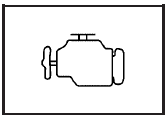Check Engine Light
A computer system called OBD II (On-Board Diagnostics-Second Generation) monitors operation of the fuel, ignition, and emission control systems.
It ensures that emissions are at acceptable levels for the life of the vehicle, helping to produce a cleaner environment.

This light should come on when the ignition is on, but the engine is not running, as a check to show it is working. If it does not, have the vehicle serviced by your dealer/retailer.
If the check engine light comes on and stays on, while the engine is running, this indicates that there is an OBD II problem and service is required.
Malfunctions often are indicated by the system before any problem is apparent. Being aware of the light can prevent more serious damage to the vehicle. This system assists the service technician in correctly diagnosing any malfunction.
Notice: If the vehicle is continually driven with this light on, after a while, the emission controls might not work as well, the vehicle’s fuel economy might not be as good, and the engine might not run as smoothly. This could lead to costly repairs that might not be covered by the vehicle warranty.
Notice: Modifications made to the engine, transmission, exhaust, intake, or fuel system of the vehicle or the replacement of the original tires with other than those of the same Tire Performance Criteria (TPC) can affect the vehicle’s emission controls and can cause this light to come on.
Modifications to these systems could lead to costly repairs not covered by the vehicle warranty. This could also result in a failure to pass a required Emission Inspection/Maintenance test. See Accessories and Modifications.
This light comes on during a malfunction in one of two ways:
Light Flashing: A misfire condition has been detected.
A misfire increases vehicle emissions and could damage the emission control system on the vehicle.
Diagnosis and service might be required.
To prevent more serious damage to the vehicle:
• Reduce vehicle speed.
• Avoid hard accelerations.
• Avoid steep uphill grades.
• If towing a trailer, reduce the amount of cargo being hauled as soon as it is possible.
If the light continues to flash, when it is safe to do so, stop the vehicle. Find a safe place to park the vehicle.
Turn the key off, wait at least 10 seconds, and restart the engine. If the light is still flashing, follow the previous steps and see your dealer/retailer for service as soon as possible.
Light On Steady: An emission control system malfunction has been detected on the vehicle. Diagnosis and service might be required.
An emission system malfunction might be corrected by doing the following:
• Make sure the fuel cap is fully installed. See Filling the Tank. The diagnostic system can determine if the fuel cap has been left off or improperly installed. A loose or missing fuel cap allows fuel to evaporate into the atmosphere. A few driving trips with the cap properly installed should turn the light off.
• If the vehicle has been driven through a deep puddle of water, the vehicle’s electrical system might be wet.
The condition is usually corrected when the electrical system dries out. A few driving trips should turn the light off.
• Make sure to fuel the vehicle with quality fuel. Poor fuel quality causes the engine not to run as efficiently as designed and can cause: stalling after start-up, stalling when the vehicle is changed into gear, misfiring, hesitation on acceleration, or stumbling on acceleration. These conditions might go away once the engine is warmed up.
If one or more of these conditions occurs, change the fuel brand used. It will require at least one full tank of the proper fuel to turn the light off.
See Gasoline Octane.
If none of the above have made the light turn off, your dealer/retailer can check the vehicle. The dealer/retailer has the proper test equipment and diagnostic tools to fix any mechanical or electrical problems that might have developed.
See also:
Secondary Latch System
Your vehicle has an underbody-mounted tire hoist
assembly equipped with a secondary latch
system. It is designed to stop the spare tire from
suddenly falling off your vehicle if the cable holding
...
First Engine Oil Change After Every
80 000 km/50,000 Miles
• Engine air cleaner filter replacement. See Engine
Air Cleaner/Filter.
• Automatic transmission fluid change (severe
service) for vehicles mainly driven in heavy
city traffic in hot weathe ...
Windshield Wiper/Washer
The windshield wiper lever is located on the left side of
the steering column.
: Use for a single wiping cycle.
: Delays wiping cycle.
: Slow wipes.
: Fast wipes.
: Turns the wiper ...


